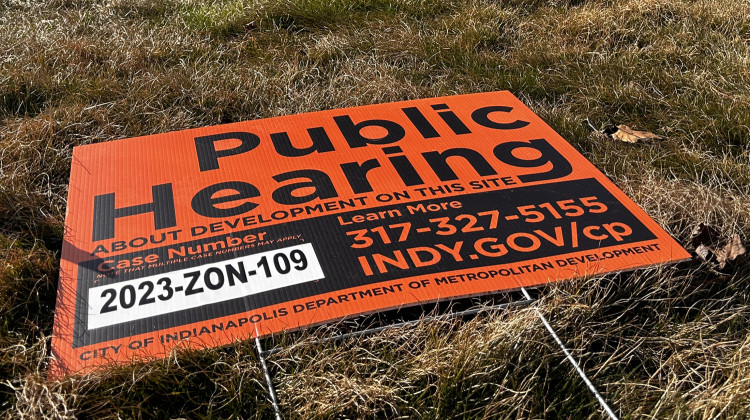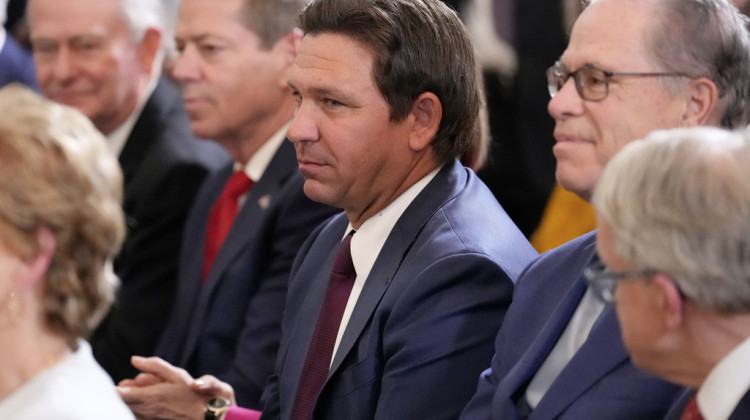
Thousands of Indiana teachers wearing red hold rally at the Statehouse in Indianapolis, Tuesday, Nov. 19, 2019, calling for further increasing teacher pay in the biggest such protest in the state amid a wave of educator activism across the country. Teacher unions says about half of Indiana's nearly 300 school districts are closed while their teachers attend Tuesday's rally while legislators gather for 2020 session organization meetings.
AP Photo/Michael ConroyTOM DAVIES, Associated Press
INDIANAPOLIS (AP) — Top Indiana Republicans touted “record investment” in school spending and big teacher pay raises by some school districts in defending themselves as thousands of teachers turned out for a Statehouse rally this past week calling for a bigger boost in education funding.
Those arguments, however, don’t give the full context of Indiana’s complicated method for distributing money for educating about 1.1 million students. And a common argument from traditional public school supporters for cutting off money for charter schools and private school vouchers has trouble as well.
A look at some of the claims:
Record Investment
“We’ve made record investment in our public schools and I don’t just mean the most money I mean the most money added,” Republican House Speaker Brian Bosma said Tuesday. “Adding three-quarters of a billion dollars to a $7 billion pie in the last budget.”
Bosma’s figures are technically true but jumble the accounting and leave out key perspective.
Republicans say the new state budget approved in April gave a “record” or “historic” boost to schools by citing the additional dollar amount going to schools.
The budget gives a projected $178 million more to K-12 education — traditional public schools, charter schools and private school vouchers — this school year and an additional $183 million increase next year. Adding the first year total twice, the second year funding once and a one-time $150 million teacher pension pay-down gets roughly to Bosma’s “three-quarters of a billion dollars.”
The GOP-written spending plan increases base funding for traditional schools funding by about 2% each year, according to an analysis from the nonpartisan Legislative Services Agency. Charter schools received 10% more money and private school voucher funding jumped 9% for this year.
Just about any increase in school funding was bound to set a record because of inflation and the spending growth from previous years, said Purdue University economist Larry DeBoer, who has studied Indiana tax policy for about 30 years.
“The increase, in total, actually was bigger this time than it’s been, but bigger this time than it’s been is just a tad above inflation,” DeBoer said.
In fact, the state’s per-student funding declined by about $300, or 4%, since 2009 to $6,863 in 2017 when adjusted for inflation, according to Indiana University’s Center for Evaluation & Education Policy.
Teacher Raises
Republican Gov. Eric Holcomb’s reelection campaign sent an email touting progress in schools raising teacher pay that cited new teacher contracts in 14 of the state’s nearly 300 school districts.
The campaign highlighted the Muncie district giving raises for the first time in eight years, increasing starting salaries to $36,500, along with the Richmond schools giving all teachers a $3,000 raise, Fort Wayne schools granting 2.5% raises and Marion County’s Franklin Township district giving 5.3% boosts.
The campaign praised the Indianapolis Public Schools for pay raises up to $9,300 in the “biggest salary increase in school history.” The Noblesville district is credited with the “largest pay increase in 40 years” for average 9.75 percent raises this year.
Holcomb’s campaign didn’t mention that voters in those two districts had approved referendums allowing increased property taxes specifically earmarked for increased teacher pay.
“Holcomb had about as much to do with teacher pay raises at IPS as he did with the moon landing,” Indiana Democratic Party Chairman John Zody said.
Education advocacy groups estimated this year that a 9% funding increase was needed to boost average teacher pay of about $50,000 a year to the midpoint of Indiana’s neighboring states, while GOP state schools Superintendent Jennifer McCormick cited a study showing Indiana as the state with the lowest teacher salary increases since 2002.
Charter and Voucher Spending
“Over 90% of all our Hoosier students attend public schools. We need our lawmakers to increase the funding for public schools and stop funding charters and vouchers,” American Federation of Teachers Indiana President GlenEva Dunham said during Tuesday’s “Red for Ed” Statehouse rally.
Many teachers argue that continued growth of the state’s charter school and private school voucher programs over the past decade have siphoned off money that could help traditional schools.
The state budget projects spending about $300 million this year on charter schools, which are public schools but generally operate independent of local school districts. About $175 million is going to the voucher program helping families pay tuition at religious or other private schools.
Supporters of those programs maintain that if they were eliminated, many, if not most, of the some 85,000 students participating would be enrolled in traditional public schools. So those schools would face hiring more teachers and support staff, leaving not much left for pay raises or new programs.
State's Dedication
Another talking point of Republicans is that 50.2% of the state budget now goes to K-12 schools.
“We’re third in the nation behind Kansas and Vermont for the percentage of state expenditures that goes exclusively for K-12 education,” Bosma said in a speech from the House rostrum Tuesday.
That is completely by choice in how the state decides to fund its schools. Indiana is somewhat unique in that it is one of only six states that don’t include local property taxes in the school funding formula, according to the national school funding advocacy group EdBuild.
Indiana relied on mix of state and local funding for schools until 2009 when Republican Gov. Mitch Daniels pushed a plan for capping local property taxes and having the state largely take over funding school operating budgets. That plan relied, in part, on increasing the state sales tax by one percentage point to its current 7% level, said DeBoer, the Purdue economist.
“The amount of additional revenue going to the whole system from the state is not the sort of extraordinary amount that would cause, or allow, great big new contracts,” DeBoer said.
 DONATE
DONATE







 Support WFYI. We can't do it without you.
Support WFYI. We can't do it without you.